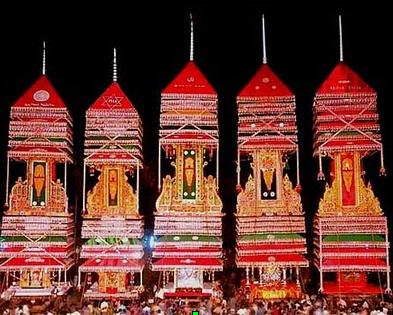Chettikulangara Kumbhabharani Festival – UNESCO recognition on the anvil!

Chettikulangara Kumbhabharani is one of the most marvelous visual spectacles in Kerala which attracts people from different parts of India and around the world. It is a festival organized annually at the Chettikulangara Bhagavati Temple situated in Mavelikkara, Kerala on the Bharani Nakshahram in the Malayalam month of Kumbham (March/April) and hence came to be known as Kumbhabharani.
The temple management with the support of the Travancore Devaswom Board is hopeful that the festival will get UNESCO recognition soon. The relevant documents are being submitted to the Sub-committee constituted by the Sree Devivilasam Hindumatha Convention, the apex body overseeing the temple and the festival.
The 1200-year old Chettikulangara Bhagavati Temple is the second largest temple in terms of income under the control of the Travancore Devaswom Board. The income from the temple is also used for managing the daily rituals and pujas at various temples under the Board.
It is believed that Parasurama who created Kerala had established 108 Durga temples, 108 Siva temples, 108 Kalaris (place to learn martial arts) and many Sastha temples. It is also believed that he had established the Jagadambika temple at Chettikulangara. There is another belief that the goddess here was a family deity, and later emerged as the local deity. One significant aspect of the temple is that the deity appears as Saraswati in the morning, as Lakshmi at noon and Durga or Bhadrakali in the evening.
There is another prevalent belief that the temple was consecrated by Acharya Padmapada, a disciple of Adi Shankaracharya in 823 A.D. It is also believed that Samudra Bandhan, a courtier of Ravi Varman, the king of Venad visited the temple and wrote poems on Bhagavati. Aditya Kulasekharan, another king of Venad (1374-1389 A.D.) is also believed to have visited the temple. However, according to some local historians the temple is not very old as it is not mentioned in Unnuneeli Sandesam, a popular work written in the 14th century.
The Kettukazhcha is a popular event associated with Kumbhabharani and is believed to have started during the early 19th century. The Kettukazhcha heralds the architectural and aesthetic wisdom of the people of Chettikulangara. The Kettukazhcha displays skillfully sculpted and decorated forms of six temple cars known as Kuthiras (Horses), five Therus (Chariots) and effigies of Bhima, Panchali, Hanuman and other epic characters. They are extremely gigantic in size and larger than similar chariots and icons built during the festivities at other temples. Kuthiras have a height of 70 to 75 feet and are a union of four parts. After mid-day, the residents bring out the floats with huge decorated effigies. During the night, the image of the Devi is carried in procession to the effigies stationed in the paddy field. This is known as Kettukazhcha. On the next day, these effigies are taken back.
The Kettukazhcha is an offering of the people to their deity known for her blessings on true devotees as a mark of gratitude and devotion. These colourful decorations are magnificent, especially during the night in the back drop of the illuminated lights. The people from 13 Karas (Administrative units) of Chettikulangara will arrange for the construction of Kettukazhcha. The Kettukazhchas have a similarity to the Buddhist architectural tradition of square, rectangular and pyramid shapes prevalent in Central Travancore in the past.
The Kuthiyottam is another event associated with Kumbhabharani. It is a ritualistic and symbolic representation of narabali (human homicide). This is an art form with well structured choreography and songs. The movements and formations of dancers are quick and culminate at a particular point and ends abruptly. There is a similarity in Padayani, folklore of Central Travancore. The traditional songs also start in a stylish slow pace, gaining momentum and ending abruptly. The Kalaris run by Kuthiyotta Asans (Teachers), train the group to perform dances and songs usually begins one or two months prior to the season. The festival goes on for seven days from Shivaratri day to Bharani asterism.
(The author is a Freelance Journalist and Social Activist. He is the Director, Indo-Gulf Consulting and can be contacted on [email protected])
Welcome to Haindava Keralam! Register for Free or Login as a privileged HK member to enjoy auto-approval of your comments and to receive periodic updates.
Latest Articles from Dharma Smriti
- In memory of Dr N Gopalakrishnan
- Treading the Middle-Path on Temple Management
- ആദി ശങ്കര ജയന്തി – പ്രഭാഷണം
- അമേരിക്കന് പ്രൊഫസര് ജോണ് ഗ്രൈംസിന് ഭഗവാന് ഗണേശന് കൊടുത്ത ദിവ്യാനുഭവം
- Forgotten Temples Of Malappuram – Part I (Nalambalam of Ramapuram)
- Holy Karkidakam – Ramayana to Echo from Haindava Homes
- Poonthanam’s complete works translated into English
- Pamba Aarati – Dispell the Engulfing Darkness
- Milords! What the judiciary must know before any final verdict on Sabarimala
- Swami Chidanandapuri on Sabarimala


Responses